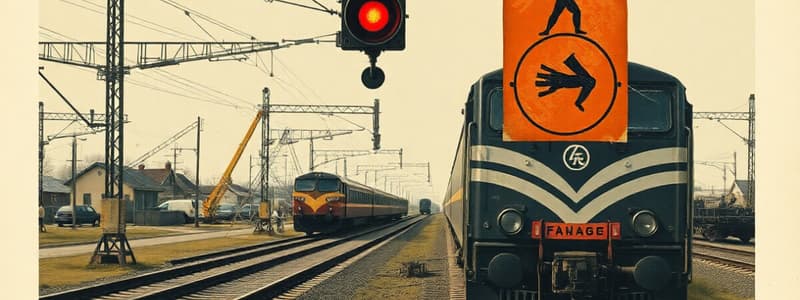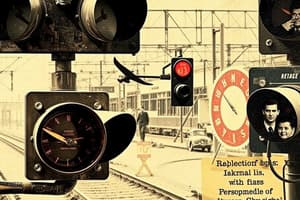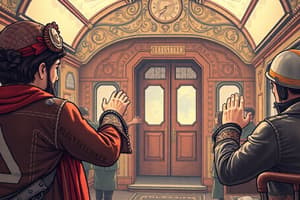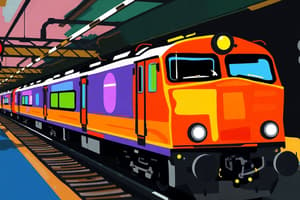Podcast
Questions and Answers
What is the first step to resume normal train operations after signals are restored?
What is the first step to resume normal train operations after signals are restored?
- Exchange messages using Private Numbers (correct)
- Check all passenger tickets for validity
- Run trains with no signals to test the system
- Notify all train crews of the changes
Who is responsible for scrutinizing the records related to train working on the Automatic Block system?
Who is responsible for scrutinizing the records related to train working on the Automatic Block system?
- The Station Master
- The Signal Maintainer
- The Divisional Railway Manager
- The Traffic Inspector (correct)
In the case of signal failure, which of the following should NOT be used as a lone means of communication?
In the case of signal failure, which of the following should NOT be used as a lone means of communication?
- Railway Auto phone
- Control Telephone
- V.H.F sets (correct)
- Inter Cabin/Station Group Telephone
What should a Loco Pilot do when encountering an Automatic Stop signal at 'On'?
What should a Loco Pilot do when encountering an Automatic Stop signal at 'On'?
What is required before any train is authorized to move over correctly set points in a signal failure situation?
What is required before any train is authorized to move over correctly set points in a signal failure situation?
How long must the Loco Pilot wait after stopping at an Automatic Stop signal at 'On' before proceeding?
How long must the Loco Pilot wait after stopping at an Automatic Stop signal at 'On' before proceeding?
What should be done to the points before any train moves in an affected area during signal failure?
What should be done to the points before any train moves in an affected area during signal failure?
What action is the Guard required to take when the train is stopped at an Automatic Stop signal?
What action is the Guard required to take when the train is stopped at an Automatic Stop signal?
During an extended signal failure, which action is the FIRST step in managing train movements?
During an extended signal failure, which action is the FIRST step in managing train movements?
What should the Loco Pilot do if the line ahead cannot be seen clearly due to weather or visibility issues?
What should the Loco Pilot do if the line ahead cannot be seen clearly due to weather or visibility issues?
If power-operated points need to be operated during signal failure, what is the required procedure?
If power-operated points need to be operated during signal failure, what is the required procedure?
What is the role of the Guard when the Loco Pilot requests assistance due to visibility issues?
What is the role of the Guard when the Loco Pilot requests assistance due to visibility issues?
What should happen after the resumption of normal working in terms of documenting the situation?
What should happen after the resumption of normal working in terms of documenting the situation?
What should the Loco Pilot do after passing an Automatic Stop signal at 'On'?
What should the Loco Pilot do after passing an Automatic Stop signal at 'On'?
What can cause an Automatic Stop signal to show 'On'?
What can cause an Automatic Stop signal to show 'On'?
What does the Loco Pilot need to do after waiting at the Automatic Stop signal if it remains at 'On'?
What does the Loco Pilot need to do after waiting at the Automatic Stop signal if it remains at 'On'?
What must be done to the points over which the train will run before the movement of any train is authorized?
What must be done to the points over which the train will run before the movement of any train is authorized?
Which communication method is NOT mentioned for obtaining Line Clear?
Which communication method is NOT mentioned for obtaining Line Clear?
What information must the Station Master propose when introducing single line working?
What information must the Station Master propose when introducing single line working?
What should the Station Master do upon finding the Last Stop signal at 'On' without apparent reason?
What should the Station Master do upon finding the Last Stop signal at 'On' without apparent reason?
What is the purpose of the written authority for Loco Pilots mentioned in the correction memo?
What is the purpose of the written authority for Loco Pilots mentioned in the correction memo?
What action should the Centralised Traffic Control Operator take upon being informed of the Last Stop signal being at 'On'?
What action should the Centralised Traffic Control Operator take upon being informed of the Last Stop signal being at 'On'?
Which of the following options is part of the information the Station Master must confirm upon introducing single line working?
Which of the following options is part of the information the Station Master must confirm upon introducing single line working?
What should the Station Master do if he cannot contact the Centralised Traffic Control Operator?
What should the Station Master do if he cannot contact the Centralised Traffic Control Operator?
If the Centralised Traffic Control Operator is unable to take 'Off' the Last Stop signal, what is the next step?
If the Centralised Traffic Control Operator is unable to take 'Off' the Last Stop signal, what is the next step?
What should the Station Master do before starting a train when unable to contact the Centralised Traffic Control Operator?
What should the Station Master do before starting a train when unable to contact the Centralised Traffic Control Operator?
What is required once the Station Master takes over Emergency Control and is unable to take 'Off' the Last Stop signal?
What is required once the Station Master takes over Emergency Control and is unable to take 'Off' the Last Stop signal?
What documentation must the Station Master issue to the Loco Pilot if he cannot take 'Off' the Last Stop signal?
What documentation must the Station Master issue to the Loco Pilot if he cannot take 'Off' the Last Stop signal?
What should not be construed as an enquiry regarding the granting of Line Clear?
What should not be construed as an enquiry regarding the granting of Line Clear?
What condition must be met before obtaining Line Clear for the next train?
What condition must be met before obtaining Line Clear for the next train?
What must be done if there is reason to suspect damage on the single line intended for temporary working?
What must be done if there is reason to suspect damage on the single line intended for temporary working?
How is the number and arrival time of completed trains communicated to the relevant Station Master?
How is the number and arrival time of completed trains communicated to the relevant Station Master?
In the case of a single line working, who takes the initial steps to introduce this procedure?
In the case of a single line working, who takes the initial steps to introduce this procedure?
What is the minimum rank required for an official to inspect a section before introducing temporary single line working?
What is the minimum rank required for an official to inspect a section before introducing temporary single line working?
Which method is prohibited for obtaining or giving Line Clear?
Which method is prohibited for obtaining or giving Line Clear?
What is the purpose of the Automatic Block System?
What is the purpose of the Automatic Block System?
What must occur before the introduction of temporary single line working is approved?
What must occur before the introduction of temporary single line working is approved?
What must the Loco Pilot do when approaching a section with unclear visibility?
What must the Loco Pilot do when approaching a section with unclear visibility?
Under what condition can a train enter an affected section without a 15-minute interval?
Under what condition can a train enter an affected section without a 15-minute interval?
Who is responsible for piloting the train when entering a tunnel?
Who is responsible for piloting the train when entering a tunnel?
What should the Loco Pilot do when approaching the next station according to special instructions?
What should the Loco Pilot do when approaching the next station according to special instructions?
What is the role of the Guard when a train is approaching a tunnel?
What is the role of the Guard when a train is approaching a tunnel?
What document does the Loco Pilot hand over at the end of a section?
What document does the Loco Pilot hand over at the end of a section?
What is the purpose of the buffer lamps and electric headlights before entering a tunnel?
What is the purpose of the buffer lamps and electric headlights before entering a tunnel?
What must be ensured before a train can enter a section behind a Stop signal?
What must be ensured before a train can enter a section behind a Stop signal?
Flashcards
Loco Pilot Action Upon Encountering 'On' Automatic Stop Signal
Loco Pilot Action Upon Encountering 'On' Automatic Stop Signal
When an 'On' Automatic Stop signal is encountered, the Loco Pilot must bring the train to a stop, wait for a specified time (1 minute during the day, 2 minutes at night), and then cautiously proceed after exchanging signals with the Guard.
Guard's Signal at Automatic Stop Signal
Guard's Signal at Automatic Stop Signal
The Guard must display a Stop hand signal when the train is stopped at an 'On' Automatic Stop signal.
Slow-Speed Operation in Reduced Visibility
Slow-Speed Operation in Reduced Visibility
When visibility is impaired (fog, rain, dust storm, curvature, or other reasons), the Loco Pilot must proceed at a very slow speed, not exceeding 10 kmph.
Guard's Assistance in Reduced Visibility
Guard's Assistance in Reduced Visibility
Signup and view all the flashcards
Guard's Role in Supporting Loco Pilot
Guard's Role in Supporting Loco Pilot
Signup and view all the flashcards
Caution After Passing 'On' Signal
Caution After Passing 'On' Signal
Signup and view all the flashcards
Cautious Approach to Subsequent Signals
Cautious Approach to Subsequent Signals
Signup and view all the flashcards
Causes of Automatic Stop Signal 'On' Position
Causes of Automatic Stop Signal 'On' Position
Signup and view all the flashcards
Station Master's role when Last Stop signal is 'On'
Station Master's role when Last Stop signal is 'On'
Signup and view all the flashcards
Centralised Traffic Control Operator's role when Last Stop signal is 'On'
Centralised Traffic Control Operator's role when Last Stop signal is 'On'
Signup and view all the flashcards
Emergency control transfer for Last Stop signal
Emergency control transfer for Last Stop signal
Signup and view all the flashcards
Station Master's action when unable to contact central control
Station Master's action when unable to contact central control
Signup and view all the flashcards
Station Master's actions after taking emergency control
Station Master's actions after taking emergency control
Signup and view all the flashcards
Loco Pilot's authority to pass Last Stop signal
Loco Pilot's authority to pass Last Stop signal
Signup and view all the flashcards
Informing about Last Stop signal does not mean line is clear
Informing about Last Stop signal does not mean line is clear
Signup and view all the flashcards
Station Master's role in ensuring safety while controlling the Last Stop signal
Station Master's role in ensuring safety while controlling the Last Stop signal
Signup and view all the flashcards
Restarting Automatic Block System
Restarting Automatic Block System
Signup and view all the flashcards
Traffic Inspector's Role in Automatic Block System
Traffic Inspector's Role in Automatic Block System
Signup and view all the flashcards
Failure of All Signals in Automatic Block Area
Failure of All Signals in Automatic Block Area
Signup and view all the flashcards
Train Control in Failed Automatic Block Area
Train Control in Failed Automatic Block Area
Signup and view all the flashcards
Setting Points in Failed Automatic Block Area
Setting Points in Failed Automatic Block Area
Signup and view all the flashcards
Operating Power Points in Failed Automatic Block Area
Operating Power Points in Failed Automatic Block Area
Signup and view all the flashcards
Informing Train Crew in Failed Automatic Block Area
Informing Train Crew in Failed Automatic Block Area
Signup and view all the flashcards
Temporary Single-Line Working
Temporary Single-Line Working
Signup and view all the flashcards
"Authority to Proceed without Line Clear"
"Authority to Proceed without Line Clear"
Signup and view all the flashcards
Record Foil Retention
Record Foil Retention
Signup and view all the flashcards
Line Inspection for Temporary Single-Line Working
Line Inspection for Temporary Single-Line Working
Signup and view all the flashcards
Communicating Train Arrivals During Obstruction
Communicating Train Arrivals During Obstruction
Signup and view all the flashcards
Minimum Train Separation
Minimum Train Separation
Signup and view all the flashcards
Automatic Block System Rules under Obstruction
Automatic Block System Rules under Obstruction
Signup and view all the flashcards
Restricted Visibility Procedures
Restricted Visibility Procedures
Signup and view all the flashcards
Tunnel Entry Procedures
Tunnel Entry Procedures
Signup and view all the flashcards
Procedure for Obstructed Automatic Block System
Procedure for Obstructed Automatic Block System
Signup and view all the flashcards
Guard's Responsibilities
Guard's Responsibilities
Signup and view all the flashcards
Requirements for Temporary Single-Line Working
Requirements for Temporary Single-Line Working
Signup and view all the flashcards
Safety Certification for Temporary Single-Line Working
Safety Certification for Temporary Single-Line Working
Signup and view all the flashcards
Approaching Designated Station
Approaching Designated Station
Signup and view all the flashcards
Communication During Obstruction
Communication During Obstruction
Signup and view all the flashcards
Authority Document Hand-off
Authority Document Hand-off
Signup and view all the flashcards
Points Setting for Automatic Block System
Points Setting for Automatic Block System
Signup and view all the flashcards
Single-Line Working Message
Single-Line Working Message
Signup and view all the flashcards
Operating Power Points for Train Diversion
Operating Power Points for Train Diversion
Signup and view all the flashcards
Single-Line Working Initiation
Single-Line Working Initiation
Signup and view all the flashcards
Line Clearance Communication Methods
Line Clearance Communication Methods
Signup and view all the flashcards
Study Notes
Automatic Block System - Double Line
- Essentials: Continuous track circuiting or axle counters are required. The line is divided into automatic block signalling sections, each controlled by a stop signal. Track circuits control signals, ensuring the line is clear not only to the next signal but also for a proper distance beyond it. Signals automatically switch to "On" when passed by a train.
- Adequate Distance: Unless otherwise specified, the distance beyond the stop signal must be at least 120 meters.
- Modified Semi-automatic Stop Signal: Under special instructions, a stop signal between two stations may be modified. This signal is interlocked with the signals at the next station and controlled by the station master. Relevant modes (normal or modified) are visible at both ends of the station. Advanced Starter signals are also interlocked, ensuring the signal is "Off" when the line is clear to the next station's home signal.
- Abnormal Conditions: In foggy or bad weather conditions, the 'A' marker on the midsection Modified Semi-automatic Stop signal can be extinguished to ensure visibility.
- Loco Pilot Duties: If a loco pilot finds the 'A' marker on a Modified Semi-automatic Stop signal is "On", they must stop the train behind the signal and wait a specified time. If the signal remains "On", the loco pilot proceeds cautiously to the next stop signal.
- Guard Duties: The guard shows a stop hand signal when the train stops.
Automatic Block System - Single Line
- Essentials: Continuous track circuiting or axle counters are required. The direction of traffic must be established. A train can only proceed to the next block after receiving "Line Clear." The line is divided into automatic block signalling sections controlled by stop signals that do not switch to 'Off' until adequate distance is clear of the next stop signal.
- Sufficient Distance: The adequate distance between signals must be at least 180 meters, unless otherwise specified.
- Modified Semi-automatic Stop Signal: Similar rules apply for Modified Semi-automatic Stop signals as in the double-line case, with the added specification that all stop signals against the traffic flow must be "On"
Minimum Equipment
- Single Line: Signal equipment includes a Home signal, Starter signal, and a stop signal behind the Home signal. Additional stop signals can be placed between stations, and further signals may be implemented for increased safety.
- Double Line: On a double line the standard equipment consists of a Home, and Starter signals with a stop signal behind the Home signal. More signals may be included depending on the needs of the line.
Duties of Loco Pilot and Guard
- Passing Signals at "On": When encountering a signal at "On," the loco pilot and guard must follow a specific procedure based on the time of the day, contacting the station master if needed. The loco pilot must proceed to the following stop signal with caution. Slow speeds (a maximum of 10 kmph) are required in certain circumstances while visibility is poor.
- Abnormal Conditions: The Loco Pilot and the Guard must consider circumstances like fog, storms, and obstructed lines to slow the train speed, and take necessary precautions.
Studying That Suits You
Use AI to generate personalized quizzes and flashcards to suit your learning preferences.
Related Documents
Description
Test your knowledge on the procedures and responsibilities during signal failures in railway operations. This quiz covers various scenarios, including communication protocols, stopping at signals, and managing train movements. Ensure you understand the correct protocols to follow for safe train operations after signals are restored.




